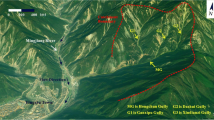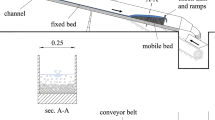Abstract
Open check dams are an efficient means of controlling debris flows within channelized gullies. To estimate the trapping and regulating functions of open check dams, it is important to have accurate predictions of the evolution of their blockade behavior. In this study, a series of specially designed physical modeling tests are performed on open check dams subjected to debris flows. Temporary blocking is observed during the trapping process as the blockade forms and breaks. The influence of opening shape, relative opening, and debris-flow bulk density on the blockade behavior is investigated, and an improved evaluation method based on the blockade criterion is proposed. Analysis allows us to determine the critical blockade conditions for various types of dam and debris flow, and to identify the range over which there is a high probability of temporary blocking. The sediment-trapping effectiveness and reduction in instantaneous discharge are strongly related to the value of the blockade criterion, making this criterion very useful for field practices. The experimental results presented in this paper provide a reference for the design of open check dams.












Similar content being viewed by others
References
Ashida K et al (1987) Debris flow control by grid dams. Annuals of DPRI of Kyoto Univ 30B–2:441–456 (in Japanese)
Ashida K, Takahashi T (1980) Study on debris flow control-hydraulic function of grid type open dam. Annuals of Disaster Prevention Research Institute, Kyoto University 23(2): 433–441
Banihabib M, Nazarieh F (2019) A model for simulation of debris flow sedimentation in slit detention-dam reservoirs. J Hydro-Environ Res 27:65–74
Bernard M, Boreggio M, Degetto M et al (2019) Model-based approach for design and performance evaluation of works controlling stony debris flows with an application to a case study at Rovina di Cancia (Venetian Dolomites, Northeast Italy). The Science of the Total Environment 688:1373–1388
Chen J, Wang D, Zhao W et al (2021) Laboratory study on the characteristics of large wood and debris flow processes at slit-check dams. Landslides 17:1703–1711
Choi S, Lee J, Kwon T (2018) Effect of slit-type barrier on characteristics of water-dominant debris flows: small-scale physical modeling. Landslides 15:111–122
D'Agostino V, Degetto M, Righetti M (2000) Experimental investigation on open check dams for coarse woody debris control. Dynamics of water and sediments in mountain basins, Quaderni di Idronomia Montana 201–212. Bios
D’Agostino V (2006) “Le opere di idraulica torrentizia per il controllo dei sedimenti [Sediments control works in mountain streams]”. Le sistemazioni idraulico-forestali per la difesa del territorio. Vol. 26. Quaderni di Idronomia Montana. (in Italian). Cosenza: Nuova Bios 231–250
Fukawa G, Katsuki S, Ishikawa N et al (2002) Simulation and stochastic evaluation of open type steel check dam for damming up performance. Proceedings of JSCE 703(703):165–176
Han W, Ou G (2006) Efficiency of slit dam prevention against non-viscous debris flow. Wuhan Univ J Nat Sci 11:865–869
Hiura M, Nakatani K, Hasegawa Y et al (2017) Sediment trap function of open-type steel sabo dam with respect to shape and installation slope. International Journal of Erosion Control Engineering 10(3):100–107
Huang X, Tang C (2014) Formation and activation of catastrophic debris flows in Baishui river basin, Sichuan province. China Landslides 11(6):955–967
Ishikawa N, Shima J, Matsubara T et al (2014) Trapping mechanism of debris flow by steel open dams, INTERPRAEVENT 2014 in the Pacific Rim, O-23, 1–6, Nov. 25–28, Nara, Japan
Itoh T, Horiuchi S, Akanuma J, Kaitsuka K et al (2011) Fundamental hydraulic flume tests focused on sediment control function using a grid-type high dam. Italian Journal of Engineering Geology and Environment. Sapienza Universit`a Editrice. Roma, 1051–1061
Lin X, Huo M, Zhou J et al (2017) An experimental study on controlling post-earthquake debris flows using slit dams. Environmental Earth Sciences 76(22):780
Marchelli M, Leonardi A, Pirulli M et al (2020) On the efficiency of slit-check dams in retaining granular flows. Geotechnique 70(3):226–237
Maricar F, Hashimoto H, Ikematsu S et al (2011) Effect of two successive check dams on debris flow deposition. Italian J Engr Geol and Environ 1073-1082
Maricar F, Hashimoto H (2014) A comparison of wood-sediment-water mixture flows at a closed type and an open type of check dams in mountain rivers. River Flow 2014 conference proceedings, 711–716. Taylor\Francis Group
Mizuno H., Bovolin V., Experimental study on effectiveness of slit type dam for controlling mudflow. International Congress, INTERPRAEVENT (2002) in the Pacific Rim-MATSUMOTO/JAPAN. Congress Publication 2:785–796
Mizuno H, Bovolin V, Minami N (2001) Study on effectiveness of reducing peak discharge of muddy debris flow with open type dams. Sabo Gakkaishi 53:45–54
Mizuyama T, Kobashi S, Mizuno H (1995) Control of passing sediment with grid-type dams. J Japan Erosion Control Engr Soc. 47(5), 8-13
Mizuyama T (2008) Structural countermeasures for debris flow disasters. International Journal of Erosion Control Engineering 1(2):38–43
Ono G, Mizuyama T, Matsumura K (2004) “Current practices in the design and evaluation of steel SABO facilities in Japan”. INTERPRAEVENT Conference Proceedings. Vol. 3. no. VII. RIVA / TRIENT 253–264
Osanai N, Mizuno H, Mizuyama T (2010) Design standard of control structures against debris flow in Japan. J Disaster Res 5(3):307–314
Parker R, Densmore A, Rosser N et al (2011) Mass wasting triggered by the 2008 Wenchuan earthquake is greater than orogenic growth. Nat Geosci 4(7):449–452
Piton G, Recking A (2016a) Design of sediment traps with open check dams. I: hydraulic and deposition processes. J Hydraul Eng 142:04015045
Piton G, Recking A (2016b) Design of sediment traps with open check dams. II: Woody debris. J Hydraul Eng 142:04015046
Schmocker L, Hager WH (2013) Scale modeling of wooden debris accumulation at a debrisrack. J Hydraul Eng 139, 827–836
Shima J, Moriyama H, Kokuryo H et al (2016) Prevention and mitigation of debris flow hazards by using steel open-type sabo dams. International Journal of Erosion Control Engineering 9(3):135–144
Shrestha BB, Nakagawa H , Kawaike K et al (2009) Capturing process of debris flow with driftwood by an open type check dam. Annuals of the disaster prevention research institute kyoto university b
Silva M, Costa S, Ricardo B et al (2016) Experimental and numerical study of slit-check dams. Int J Sustain Dev Plan 11(2):107–118
Sun H, You Y, Liu J et al (2021) Experimental study on discharge process regulation to debris flow with open-type check dams. Landslides 18:967–978
Sun H, You Y, Liu J (2018a) Experimental study on blocking and self-cleaning behaviors of beam dam in debris flow hazard mitigation. Int J Sedim Res 33:395–405
Sun H, You Y, Liu J (2018b) Experimental study on characteristics of trapping and regulating sediment with an open-type check dam in debris flow hazard mitigation. J Mt Sci 15(9):2001–2012
Takahashi T, Nakagawa H, Satofuka Y et al (2001) Stochastic model of blocking for a grid-type dam by large boulders in a debris flow. Annual Journal of Hydraulic Engineering JSCE 45:703–708
Takahara T et al (2007) Evaluation of sediment trap of ability based on sediment mode and members distance. Journal of the Japan Society of Erosion Control Engineering 60(4):55–60 (in Japanese)
Wehrmann H, Hu¨bl J, Holzinger G (2006) Classification of dams in torrential watersheds. INTERPRAEVENT Conference Proceedings, 829–838. Universal Academy Press, Inc. Tokyo, Japan
Zhou G, Hu H, Song D et al (2019) Experimental study on the regulation function of slit dam against debris flows. Landslides 16(1):75–90
Funding
This study was funded by the Second Scientific Expedition to Qinghai-Tibet Plateau (Grant No. 2019QZKK0902), the National Research and Development Program of China (Grant No. 2020YFD1100701), the Strategic Priority Research Program of Chinese Academy of Sciences (Grant No. XDA23090403). Furthermore, we would like to thank the anonymous reviewers and editors for their comments.
Author information
Authors and Affiliations
Corresponding author
Rights and permissions
About this article
Cite this article
Sun, H., You, Y., Li, D. et al. Improving the evaluation of the blockade behavior of open check dams: a small-scale physical modeling. Bull Eng Geol Environ 81, 279 (2022). https://doi.org/10.1007/s10064-022-02773-1
Received:
Accepted:
Published:
DOI: https://doi.org/10.1007/s10064-022-02773-1




